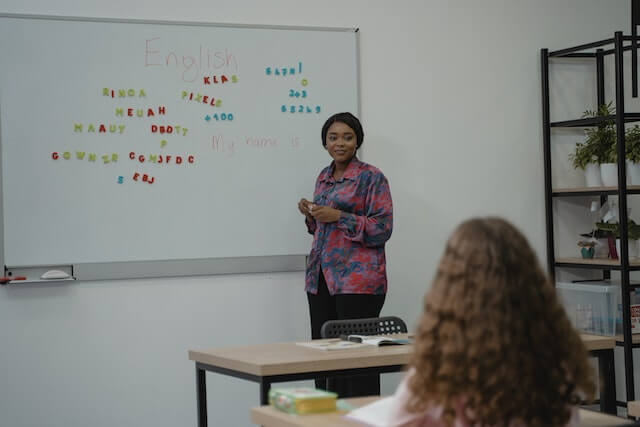Imagine that you a first-year student in a class with 75% students studying English as a Second Language (ESL) and you have been given medical documents to teach these students in your first-year class. Or imagine you are a teacher teaching ESL students using a text with technical jargon.
The first thing you will need to do is to select ESL instructional strategies which will help you simplify the technical vocabulary or jargon in the reading materials.
Understanding the nature of vocabulary is important to the process of selecting appropriate instructional strategies that enable students to master the vocabulary they need to learn.
When we use vocabulary in sentences or phrases, we carefully select function words and content words. We do not need to think about this process when we speak. It comes naturally if we know the language.
Function words are common words, such as are, with, of, that, and to. Content words include nouns, verbs, adjectives, and adverbs, like flower, eat, beautiful, and sadly. Function words perform grammatical function while content words convey the meaning of the sentence.
Further, content words are comprised of both concrete and abstract words. Finally, words may be considered to belong to either general vocabulary or technical vocabulary.
General vocabulary refers to words, such as giant, man, people, animal that are not directly associated with a particular content area, while technical vocabulary, like alleles, barometric, bacteria, are associated with a specific content area, subject, or topic (O’Toole & Laugesen, 2011).
These words find their way in subjects such English which are not scientific in nature. As a result, learners should be taught how they can overcome difficulties posed by such words which are of scientific style when reading.
The purpose of this article is to share some of the common ESL instructional strategies and classroom activities which you can use to help learners to overcome the language difficulties posed by the language style characteristic of a specific subject area.
Words in Context as an ESL Instructional Strategy
When reading a text which has language style characteristic of a specific subject area, students will encounter unknown words. When they encounter new words, as Laufer and Yano (2001) point out, learners have two options: either to keep on learning words or to use some reading strategies; for example, they can (a) ignore the unimportant word, (b) look it up in a dictionary, or (c) infer its meaning from context.
Studies (Laufer 1997; Paribakht 2004; Qian 2004; Ying 2001) have shown that the most used strategy in these situations is the last-mentioned one: learners make an attempt to guess the meaning of unknown words in order to compensate for the lack of comprehension.
The reason why guessing has been investigated widely by so many scholars (Hulstijn 1992) mainly reflects the assumption that the greater the mental effort in processing a word, the more likely it is to be remembered.
This recommendation is supported by the evidence that the retention of words that are difficult to guess is superior to that of words whose meaning can be easily inferred from context (Hulstijn 1992; Mondria and Wit-de Boer 1991).
Guessing is useful only when you can interpret or understand the surrounding text. Inferring and guessing meanings of unfamiliar words is, thus, one of ESL instructional strategies which is worth developing in your learning process particularly in those situations when there is no dictionary available.
Studies have suggested that different levels of meaning could be obtained from the same material (Qian 2004). He identified literal level which relates the material to its context, a significance level which involves implications and an evaluative level which requires the reader to react to the material in his own terms.
Reading requires you to make inferences that depend on your previous knowledge. Guessing the lexical and contextual meanings is the first step in understanding a written message.
A reader’s use of textual clues for guessing is affected by their knowledge of grammar (Paribakht and Wesche 1999; Paribakht 2004). In Kelly’s (1990) words, if one form of a word is known, the meaning of the other word in the same language can be deduced. As suggested by Kelly (1990), topic familiarity, will play a role in a learner’s success in guessing.
Paribakht’s (2004) study highlights how learners frequently make use of their background knowledge to assist guessing the meaning of unknown or scientific words.
Thus, if the topic is unfamiliar or very technical or abstract, then guessing will be considerably more difficult. This is so because the meaning of words are not static but dependent on how we use them and mostly, scientific words are used with meanings that are different to those given in small dictionaries (O’Toole & Laugesen, 2011).
Activities in this approach would include looking at a word and deciding the class to which it belongs. Determine whether it is a noun, verb, or adjective or any other word. Then look at how it is connected in a sentence.
Ask yourself the following questions: what kind of word does it link with, what these linked words mean (O’Toole & Laugesen, 2011)?
The way words connect in a sentence is called co-text. Then look at the sentence or clause containing it and see how this clause or sentence relates to other sentences or clauses.
Then you can guess the meaning. The rationale behind this activity is that the words contribute to the overall meaning of a passage which gives it the contextual meaning. Further the context created by the words and sentences in the whole passage can help one deduce the meaning of individual words which may be scientific in nature.
Roots And Word Families as ESL Instructional Strategies
In morphology, words are divided into different constituent parts. Word meaning derives from their stems. A very effective way of remembering new vocabulary is to relate it to words that are already known and that contain the same word stem.
As O’Toole & Laugesen (2011) simply put it, ‘many specialist words are made up of bits of words from other languages…. Many of the same “root words” occur again and again in specialist writing.
Very simply, the word part technique or the root approach involves connecting a new word to be learned with an already known word which contains the same word part.
So, if the teacher wants to help the learners learn a new word or jargon, say aware, the teacher needs to point out to them that they already know the word aware which contains the same word part -war- which has the same meaning in both words, namely “to watch something carefully”.
Let’s look at a clearer example. The high frequency word describe shares the same stem –scrib(e)- with the lower frequency words scribble, subscribe, prescribe, scribe, transcribe and inscribe.
These words are similar in form as they all have the word part –scrib(e)- in them. Moreover, they are closely related in meaning because the meaning constant “write” can be found in all of them:
| Word | Meaning |
| Scribble | to write hastily or carelessly |
| Subscribe | to write down one’s name as a buyer of shares or a magazine |
| Prescribe | to write down one’s name as a buyer of shares or a magazine |
| Scribe | somebody in the past who made copies of pieces of writing |
| Transcribe | to put speech into written form |
| inscribe | to write words and symbols on something |
| Describe | to write about the features of something |
There are many reasons why teachers should use this ESL instructional strategy. Almost 60% of English vocabulary comes from French, Latin, or Greek. Related to this is the approach or concept of language family.
Word families are groups of words that have a common feature or pattern. They usually share a common base or root word, to which different prefixes and suffixes are added.
These languages make use of word parts prefixes, suffixes, and word stems. So, there is a very large number of words that the word part technique can be used with.
Recent research has shown that there are at least 2000-word families which belong largely to the mid-frequency words of English (from the 3rd1000 to the 10th1000) which have useful word stem connections with the high frequency words from the most frequent 2000 words of English.
These can be studied using the Structural Analysis Approach. Instruction in structural analysis looks at visual patterns and meanings that change because of adding inflectional endings, prefixes, and suffixes, and combining the root words to form compounds.
Assisting students in practicing in structural analysis will provide them with a way to not only pronounce and identify a word, but also to unlock the meaning by considering the word parts used in the structure of the word.
Structural analysis activities help students learn how to use what they already understand about words and word parts so that they can add it into their arsenal of word attack tools. Even the creation of nonsense words, using a variety of affixes, base words, and root words can support in their word knowledge.
Put Reading First (2001) state that, “knowing some common prefixes and suffixes (affixes), base words, and root words can help students learn the meanings of many new words” and that “if students learn just the four most common prefixes in English (un ‐, re ‐, in ‐, dis ‐), they will have important clues about the meaning of about two thirds of all English words that have prefixes” (p.38).
Activities in such ESL instructional strategies may include the student being taught to construct a visual image that connects the vocabulary word being taught with a familiar, concrete word that is similar auditorily and shares some common phonological features. The following are the steps that the teacher may follow:
- Give students a new vocabulary word and share its meaning with them. (Example biology, which means “study of life”).
- Ask them to identify a familiar word that is acoustically like biology (example: the keyword “biography”)
- Have students visualize or draw the image of an old woman driving a car.
When asked to recall the meaning of biology, the student will retrieve biography because of its acoustic similarity to “biology’, and then recall the visual image of the meaning of biology (Baumann & Kameenui, 1991).
Definition as an Instructional strategy
O’Toole & Laugesen (2011. p. 121) points out that, ‘definitions in science are very common’. Providing definitions or descriptions of new words is also a way of teaching and learning new vocabulary of vocabulary with specialist style.
Bright (1970 p. 40) states that, ‘the ability to produce short, clear relevant definitions of words is important to the teacher’.
The teacher thinks about the feature that he should capture and what contrast to make. According to Nation (1990, p. 56) to define a word is to show or explain its meaning.
An adequate definition of a word shows its meaning as distinct from the meaning of other words and nothing but its meaning. In other words, it aims to the characteristics which belong to this concept as distinct from others, it makes the boundaries of a concept as clear by given some indications of the range of situation to which the symbol can refer (Nation (1990).
An adequate definition indicates the grammatical function or the category of the word, a noun, verb, an adjective, it also indicates the typical sentence pattern in which the word enters and finally it indicates other formal aspects of the word.
Activities in this approach may include marching technical words with meanings in a table as shown below.
| Technical word | Definition |
| Photosynthesis | The science which deals with the physical structure and substance of the earth, their history, and the processes which act on them. |
| Translucent | Each of two or more alternative forms of a gene that arise by mutation and are found at the same place on a chromosome. |
| Geology | (Of a substance) allowing light, but not detailed shapes, to pass through; semi-transparent. |
| Allele | The process by which green plants and some other organisms use sunlight to synthesize nutrients from carbon dioxide and water. |
In this activity, the role of the learner is to sort and match the meanings in the correct box by either moving the scientific words to the right definition or by shifting the definiens to the right word.
Using a science dictionary
Using dictionary as a strategy of learning new words in a foreign language is considered as one of the most fruitful strategies. This area has been discussed by many writers, such as Bright, taking secondary learners as a sample.
Medan also has covered this area with different point of view. He concentrated on types of dictionaries in relation to learner’s level. Medani (1994) discussed the same issue focusing on types of learners (good and weak learners), Wallace had slightly touched the same topic explaining (setting) suitable tasks for each skill as to find the meaning of difficult word, rearranging words, and spelling check.
It has been stressed that using dictionary according to beginners may lead them to a complex and ambiguous process of learning. Although it can be a useful learning resource, it makes the learner more independent of his teacher. Scholars have agreed that the choice of a particular dictionary rather, than others depend mainly on the level of the learners (Bright, 1970, Medani, 1994).
Learners can look into a dictionary for many purposes for examples to rearrange words which are out of the alphabetical order to find the leaning of a difficult word, to find derived forms under mother head word, to find out pronunciation and to check spelling of the target words.
Learners should be aware of these dictionaries to get much information. They should be sure that they have the ability of choosing appropriate meaning. Bright (1970) has suggested a procedure for testing learners to know whose command is shaky.
Much discussion has been on the use of both monolingual and bilingual dictionary. Some writers think that “in addition to personal dictionaries all learners should have access to advance learner’s dictionary”. Medani (1994, p. 133) made a survey of which type of the dictionary is preferred. He was satisfied just by the answer “many students used both types”.
McCarthy (1990) states that the disapproval of teachers may be caused by students who uses bilingual one which may lead learners to misuse the collocation of words. Nation (1990) encourages the use of monolingual dictionaries although there is a need for bilingual one. He says: “the best dictionaries for productive purposes are monolingual that is, the meaning and extra information is given in the same language as the word.
Text Simplification
Text simplification is a common practice in special education to place students with mild learning problems in the regular classroom for courses in science and social studies.
One difficulty with this arrangement is the reading level of the textbooks used for these content area subjects. From upper elementary through secondary levels, the readability of textbooks is often higher than the assigned grade (Johnson & Vardian, 1973).
In addition, the unfamiliarity of the content and vocabulary place a greater burden on the reader (Lunstrum, 1976). Further, O’Toole and Laugesen (2011) add that lot of scientific writing is tightly packed.
Reading can be made easier if these tightly packed sentences are unpacked into ideas simple to read. This calls for text simplification so as to unpack tightly packed ideas and difficulty words.
The goal of text simplification is to rewrite complex text into simpler language that is easier to understand. Research into this topic has many potential practical applications.
For instance, it can provide reading aids for people with disabilities (Carroll et al., 1999; Canning et al., 2000; Inui et al., 2003), low-literacy (Watanabe et al., 2009; De Belder and Moens, 2010), non-native backgrounds (Petersen and Ostendorf, 2007; Allen, 2009) or non-expert knowledge (Elhadad and Sutaria, 2007; Siddharthan and Katsos, 2010).
Text simplification may also help improve the performance of many natural language processing (NLP) tasks, such as parsing (Chandrasekar et al., 1996), summarization (Siddharthan et al., 2004; Klebanov et al., 2004; Vanderwende et al., 2007; Xu and Grishman, 2009), semantic role labeling (Vickrey and Koller, 2008), information extraction (Miwa et al., 2010) and machine translation (Gerber and Hovy, 1998; Chen et al., 2012), by transforming long, complex sentences into ones that are more easily processed.
Activities in this approach might include transformation exercises where learners rewrite the sentences with the help of the teacher who facilities the process.
Last word ESL Instructional Strategies
This essay was an attempt to propose approaches and activities that which may help learners to overcome the language difficulties posed by the language style characteristic of a specific subject area. The essay has discussed the words in context approach, roots and word families approach, definition approach, dictionary and text simplification.
References
Allen, D. (2009). A study of the role of relative clauses in the simplification of news texts for learners of English. System, 37(4):585–599.
Baumann, J. F., & Kameenui, E. J. (1991). Research on vocabulary instruction: Ode to Voltaire. In J. Flood, J. D. Lapp, & J. R. Squire (Eds.), Handbook of research on teaching the English language arts (pp. 604-632). New York: MacMillan
Carroll, J., Minnen, G., Pearce, D., Canning, Y., Devlin, S., and Tait, J. (1999). Simplifying text for language-impaired readers. In Proceedings of the 14th Conference of the 9th European Conference for Computational Linguistics (EACL)
Canning, Y., Tait, J., Archibald, J., and Crawley, R. (2000). Cohesive generation of syntactically simplified newspaper text. In Proceedings of the Third International Workshop on Text, Speech and Dialogue (TSD).
Chandrasekar, R., Doran, C., and Srinivas, B. (1996). Motivations and methods for text simplification. In Proceedings of the 16th Conference on Computational linguistics (COLING)
Chen, H.-B., Huang, H.-H., Chen, H.-H., and Tan, C.-T. (2012). A simplification-translation restoration framework for cross-domain smt applications. In Proceedings of the 24th International Conference on Computational Linguistics (COLING)
De Belder, J. and Moens, M.-F. (2010). Text simplification for children. In Proceedings of the SIGIR Workshop on Accessible Search Systems.
Elhadad, N. and Sutaria, K. (2007). Mining a lexicon of technical terms and lay equivalents. In Proceedings of the Workshop on BioNLP 2007: Biological, Translational, and Clinical Language Processing. Learners Understand How Much They Don’t Understand? Reading in a Foreign Language 13(2): 549-66.
Miwa, M., Saetre, R., Miyao, Y., and Tsujii, J. (2010). Entity-focused sentence simplification for relation extraction. In Proceedings of the 24th International Conference on Computational Linguistics (COLING).length. In Machine Translation and the Information Soup, pages 448–460. Springer.
Hulstijn, J.H. (1992). Retention of inferred and given word meanings: experiments in incidental vocabulary learning, in P.J.L. Arnaud and H. Bejoint (eds.), Vocabulary and Applied Linguistics,113-25. London: Macmillan
Inui, K., Fujita, A., Takahashi, T., Iida, R., and Iwakura, T. (2003). Text simplification for reading assistance: A project note. In Proceedings of the 2nd International Workshop on Paraphrasing.
Kelly, P. (1990). Guessing: no substitute for systematic learning of lexis’, System 18(2): 199-207.
Klebanov, B. B., Knight, K., and Marcu, D. (2004). Text simplification for information-seeking applications. In On the Move to Meaningful Internet Systems 2004: CoopIS, DOA, and ODBASE, pages 735–747. Springer
Laufer, B., and Yano, Y. (2001). Understanding Unfamiliar Words in a Text: Do L2
Laufer, B. (1997). The lexical plight in second language reading: Words you don’t know, words you think you know and words you can’t guess. In J. Coady, & T. Huckin (Eds.), Second Language Vocabulary Acquisition: A Rationale for Pedagogy (pp. 20-34). Cambridge University Press.
Mc Carthy, M. (1990). Vocabulary Language Teaching: A Scheme for Teacher Education. Oxford: OUP.
Mondria, J.-A., and Wit-de Boer, M. (1991). The effects of contextual richness on the guessability and the retention of words in a foreign language’, Applied Linguistics 12: 249-67.
Nation, I.S.P. (1990). Teaching and Learning Vocabulary. New York: Newbury House
O’Toole, J. M., Burke, R. & Absalom, D. (2012). Language, literacies and learning: A first introduction. Sydney: Boraga Academic.
O’Toole, J. M. & Laugesen, R. (2011). Developing specialist language styles: Research and application. Sydney: Boraga Academic.
Paribakht, T.S. (2004). The role of grammar in second language learning processing’, RELC 35(2): 149-60.
Paribakht, T.S., and Wesche, M. (1999). Reading and “incidental” l2 vocabulary acquisition: an introspective study of lexical inferencing’, Studies in Second Language Acquisition 21(2): 195-224.
Petersen, S. and Ostendorf, M. (2007). Text simplification for language learners: A corpus analysis. In Proceedings of the Workshop on Speech and Language Technology for Education
Qian, D. (2004). Second language lexical inferencing: preferences, perceptions and practices, in P. Bogaards and B. Laufer (eds.), Vocabulary in a Second Language 155-69. Amsterdam/Philadelphia: John Benjamins
Siddharthan, A. and Katsos, N. (2010). Reformulating discourse connectives for non-expert readers. In Proceedings of the 2010 Annual Conference of the North American Chapter of the Association for Computational Linguistics: Human Language Technologies (NAACL-HLT)
Siddharthan, A., Nenkova, A., and McKeown, K. (2004). Syntactic simplification for improving content selection in multi-document summarization. In Proceedings of the 20th International Conference on Computational Linguistics (COLING)
Vanderwende, L., Suzuki, H., Brockett, C., and Nenkova, A. (2007). Beyond Sum Basic: Task-focused summarization with sentence simplification and lexical expansion. Information Processing & Management, 43(6):1606–1618
Vickrey, D. and Koller, D. (2008). Sentence simplification for semantic role labeling. In Proceedings of the 46th Annual Meeting of the Association for Computational Linguistics: Human Language Technologies (ACL-HLT)
Watanabe, W. M., Junior, A. C., Uzêda, V. R., Fortes, R. P. d. M., Pardo, T. A. S., and Aluísio,S. M. (2009). Facilita: reading assistance for lowliteracy readers. In Proceedings of the 27th ACM International Conference on Design of Communication
Xu, W. and Grishman, R. (2009). A parse-and-trim approach with information significance for chinese sentence compression. In Proceedings of the 2009 Workshop on Language Generation and Summarisation
Ying, S. (2001). Acquiring Vocabulary through a Context-based Approach’, Forum 39(1).







